Benefits of Aloe: Bioactive Components and Biological Activities
Aloe vera is rich in diverse bioactive compounds that contribute to its antioxidant, anti-inflammatory, and skin-supporting properties. Research highlights several key components and their mechanisms:
- Anthraquinones (e.g., Aloe-emodin, Aloin): Exhibit antioxidant and anti-inflammatory effects by modulating NF-κB/MAPK pathways, and show antimicrobial activity by disrupting microbial protein and DNA synthesis.
- Polysaccharides (e.g., Acemannan): Support immune activation, promote fibroblast growth and collagen production for wound repair, and help protect against oxidative and metabolic stress.
- Sterols (e.g., β-Sitosterol): Inhibit COX-2 to reduce inflammation and stabilize membranes under oxidative conditions.
- Enzymes (e.g., SOD, Bradykininase): Neutralize free radicals and reduce edema, aiding in cellular protection.
- Vitamins/Minerals (e.g., C, E, Zinc): Contribute to antioxidant defense and tissue regeneration.
- Flavonoids: Provide additional anti-inflammatory support and oxidative stability.
What Are Aloe-Derived Exosomes?
Aloe-derived exosomes are nanoscale extracellular vesicles (EVs) obtained from Aloe plant tissues. They act as natural carriers of Aloe-specific bioactive molecules and play roles in plant-based intercellular communication. Their main characteristics include:
- Structural Features: Spherical in shape with a lipid bilayer membrane, typically 100-200 nm in diameter. Particle size analysis shows a main distribution peak around 200 nm, with a minor range extending to 300-600 nm.
- Molecular Composition: Contain Aloe-specific bioactive components such as polysaccharides, functional proteins, and nucleic acids. SDS-PAGE analysis reveals major protein bands near 15 kDa, suggesting consistent protein enrichment.
- Isolation Method: The standard procedure involves homogenizing Aloe tissue, followed by a series of centrifugation steps. Low-speed centrifugation removes debris, and ultracentrifugation at 150,000 g allows for the collection of vesicles. The final pellet is resuspended in phosphate-buffered saline (PBS) for further use.
These features make Aloe-derived exosomes a unique category of plant EVs with growing relevance in natural product and nanobiotechnology research.
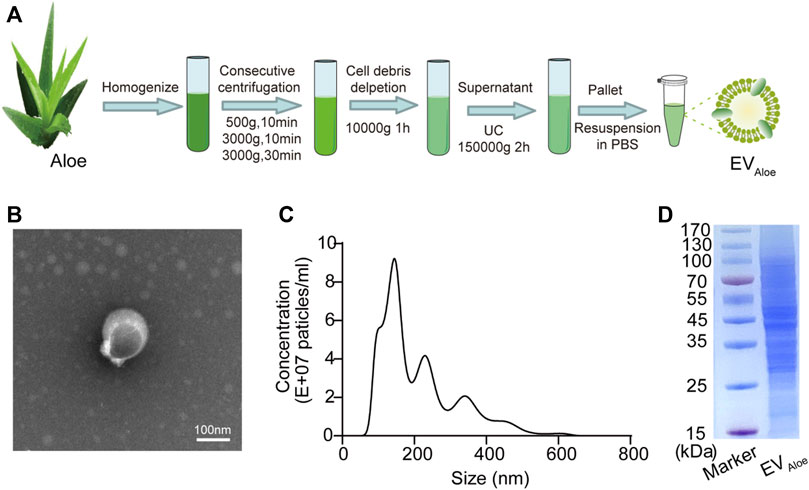 Isolation and Characterization of Aloe-Derived Extracellular Vesicle-Like Nanoparticles (EVAloe). (A) Schematic of EVAloe preparation involving differential centrifugation and sucrose gradient ultracentrifugation. (B) Transmission electron microscopy (TEM) image showing the morphology of EVAloe obtained from the 45% sucrose fraction. Scale bar: 100 nm. (C) Size distribution profile of EVAloe measured using nanoparticle tracking analysis (NTA). (D) SDS-PAGE analysis of EVAloe protein content using 10% polyacrylamide gel. (Zhou H, et al., 2023)
Isolation and Characterization of Aloe-Derived Extracellular Vesicle-Like Nanoparticles (EVAloe). (A) Schematic of EVAloe preparation involving differential centrifugation and sucrose gradient ultracentrifugation. (B) Transmission electron microscopy (TEM) image showing the morphology of EVAloe obtained from the 45% sucrose fraction. Scale bar: 100 nm. (C) Size distribution profile of EVAloe measured using nanoparticle tracking analysis (NTA). (D) SDS-PAGE analysis of EVAloe protein content using 10% polyacrylamide gel. (Zhou H, et al., 2023)
Advantages of Aloe-Derived Exosomes
Aloe-derived exosomes offer several distinct advantages compared to synthetic or animal-derived extracellular vesicles, making them an attractive platform for advanced biomedical and biotechnology research:
Excellent Biocompatibility and Safety
In vitro studies have shown that Aloe exosomes do not induce cytotoxic effects in fibroblasts or endothelial cells, supporting their suitability for prolonged exposure. Being plant-derived, they carry no risk of animal pathogen transmission and do not require genetic modification.
Anti-Inflammatory and Immunomodulatory Potential
Aloe exosomes have been shown to reprogram macrophages from pro-inflammatory (M1) to anti-inflammatory (M2) phenotypes, significantly reducing the expression of cytokines such as TNF-α and IL-6. In preclinical infection models, they alleviated tissue damage and cytokine storm responses. They have also demonstrated potential in promoting chronic wound repair by downregulating inflammatory genes (e.g., COX-2, iNOS) and enhancing fibroblast migration and proliferation.
Efficient Drug Delivery Capability
Due to their nano-scale size (100-200 nm), Aloe exosomes can penetrate biological barriers such as the skin or intestinal mucosa. Their lipid bilayer structure protects encapsulated agents from enzymatic degradation, improving stability and circulation time. They have been used to deliver hydrophobic drugs, such as indocyanine green, for targeted photo-therapeutic studies, and inherently carry bioactive Aloe compounds like acemannan without chemical modification.
Rich in Bioactive Components
Aloe exosomes contain a variety of naturally functional molecules.
- Acemannan (Polysaccharide): Stimulates immune activity, supports antiviral responses, and promotes wound healing.
- Aloe-emodin (Phenolic compound): Exhibits antioxidant and anti-tumor properties.
- β-Sitosterol (Sterol): Contributes to anti-inflammatory and cholesterol-lowering effects.
- Superoxide Dismutase (Enzyme): Acts as a free radical scavenger and protects against oxidative damage.
Scalability and Manufacturing Feasibility
Cultivation of Aloe vera through optimized tissue culture protocols enables high propagation efficiency, with survival rates above 90%. Innovative extraction methods, including supercritical CO₂ and enzyme-assisted membrane filtration, enhance yield and preserve the integrity of heat-sensitive or bioactive components.
These combined advantages position Aloe-derived exosomes as a promising, plant-based extracellular vesicle platform for diverse research applications.
References
- Kim M K, Choi Y C, Cho S H, et al. The antioxidant effect of small extracellular vesicles derived from aloe vera peels for wound healing. Tissue Engineering and Regenerative Medicine. 2021, 18: 561-571.
- Zeng L, Wang H, Shi W, et al. Aloe derived nanovesicle as a functional carrier for indocyanine green encapsulation and phototherapy. Journal of Nanobiotechnology. 2021, 19: 1-24.
- Kim M, Park J H. Isolation of aloe saponaria-derived extracellular vesicles and investigation of their potential for chronic wound healing. Pharmaceutics. 2022, 14(9): 1905.
- Kim D M, Kim W J, Lee H K, et al. Skin improvement of the composition containing nano-exosome derived from Aloe vera bark callus as new type of transdermal delivery system. Asian Journal of Beauty and Cosmetology. 2023, 21(1): 117-130.
- Zhou H, Peng K, Wang J, et al. Aloe-derived vesicles enable macrophage reprogramming to regulate the inflammatory immune environment. Frontiers in Bioengineering and Biotechnology. 2023, 11: 1339941.
- Calzoni E, Bertoldi A, Cesaretti A, et al. Aloe Extracellular Vesicles as Carriers of Photoinducible Metabolites Exhibiting Cellular Phototoxicity. Cells. 2024, 13(22): 1845.
- Zeng L, Shi W, Chen K, et al. Indocyanine Green Aggregation-Induced Hypotonic Stress to Remodel Aloe Exosome-like Vesicles for Enhanced Tumor Penetration and Phototherapy. ACS nano. 2025, 19(16): 15425-15443.
- Sun Z, Zheng Y, Wang T, et al. Aloe Vera Gel and Rind-Derived Nanoparticles Mitigate Skin Photoaging via Activation of Nrf2/ARE Pathway. International Journal of Nanomedicine. 2025: 4051-4067.
 Isolation and Characterization of Aloe-Derived Extracellular Vesicle-Like Nanoparticles (EVAloe). (A) Schematic of EVAloe preparation involving differential centrifugation and sucrose gradient ultracentrifugation. (B) Transmission electron microscopy (TEM) image showing the morphology of EVAloe obtained from the 45% sucrose fraction. Scale bar: 100 nm. (C) Size distribution profile of EVAloe measured using nanoparticle tracking analysis (NTA). (D) SDS-PAGE analysis of EVAloe protein content using 10% polyacrylamide gel. (Zhou H, et al., 2023)
Isolation and Characterization of Aloe-Derived Extracellular Vesicle-Like Nanoparticles (EVAloe). (A) Schematic of EVAloe preparation involving differential centrifugation and sucrose gradient ultracentrifugation. (B) Transmission electron microscopy (TEM) image showing the morphology of EVAloe obtained from the 45% sucrose fraction. Scale bar: 100 nm. (C) Size distribution profile of EVAloe measured using nanoparticle tracking analysis (NTA). (D) SDS-PAGE analysis of EVAloe protein content using 10% polyacrylamide gel. (Zhou H, et al., 2023)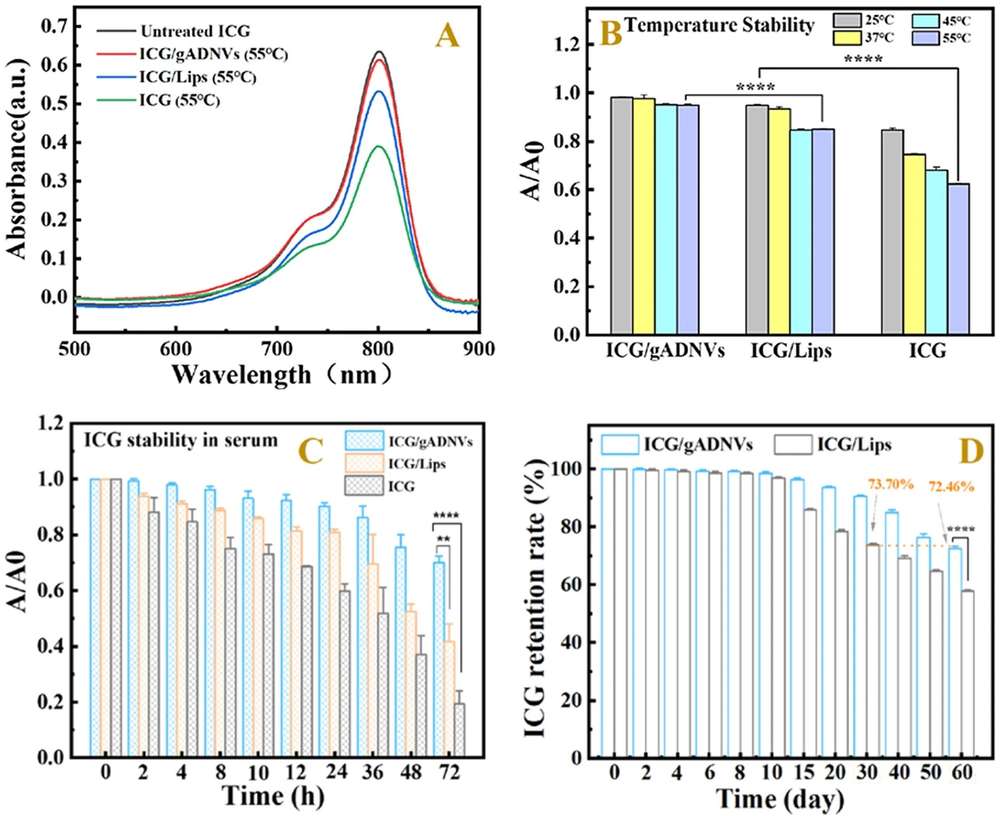 Figure 1. Evaluation of ICG Stability and Leakage in gADNVs Compared to Liposomes and Free ICG. (A) UV-vis spectra of ICG/gADNVs, ICG/Lips, and free ICG after 12 h at 55 °C. (B) Thermal stability comparison of ICG in different carriers. A/A₀ indicates the ratio of absorbance before and after heating. (C) Stability of ICG/gADNVs, ICG/Lips, and free ICG in serum. (D) Long-term retention rates of ICG in gADNVs and liposomes over 60 days.
Figure 1. Evaluation of ICG Stability and Leakage in gADNVs Compared to Liposomes and Free ICG. (A) UV-vis spectra of ICG/gADNVs, ICG/Lips, and free ICG after 12 h at 55 °C. (B) Thermal stability comparison of ICG in different carriers. A/A₀ indicates the ratio of absorbance before and after heating. (C) Stability of ICG/gADNVs, ICG/Lips, and free ICG in serum. (D) Long-term retention rates of ICG in gADNVs and liposomes over 60 days.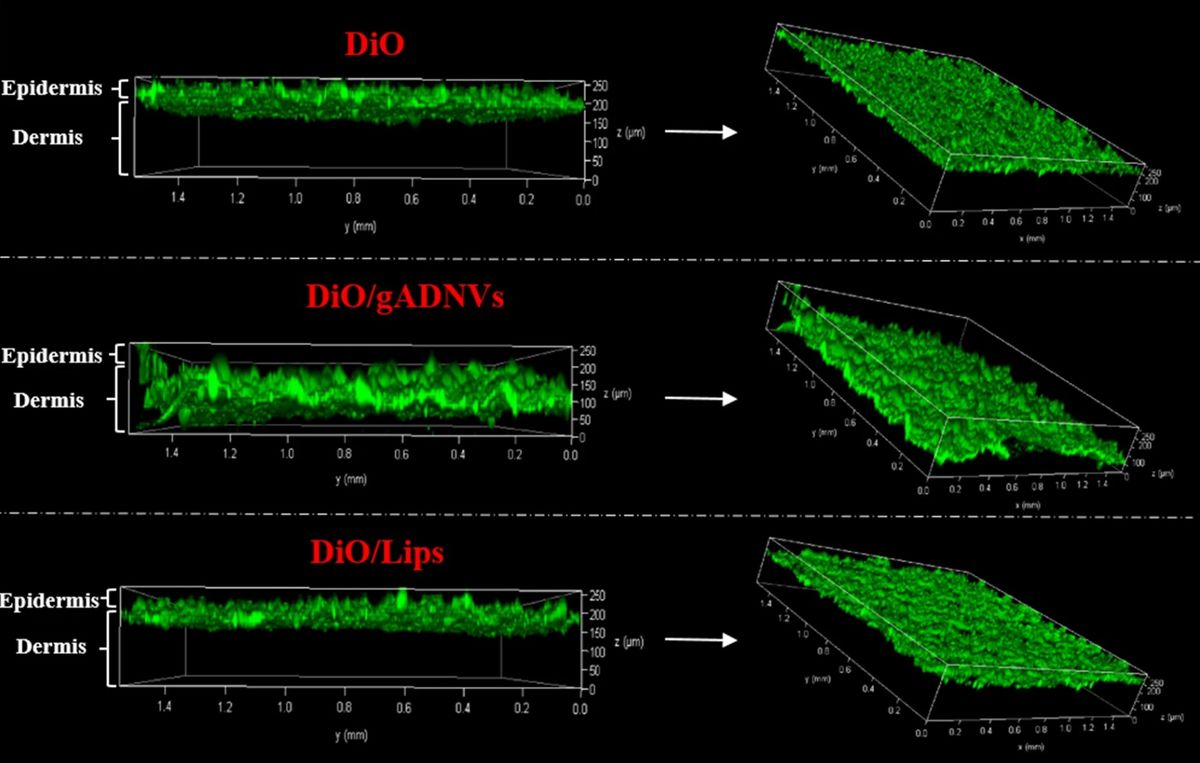 Figure 2. Enhanced Dermal Penetration of DiO via gADNVs Compared to Free DiO and Liposomes. Laser scanning confocal microscopy images showing the skin penetration of free DiO, DiO-loaded gADNVs, and DiO-loaded liposomes (DiO/Lips). DiO/gADNVs penetrated into the dermis with a broader distribution, while free DiO and DiO/Lips primarily remained in the epidermis, suggesting the potential of gADNVs as effective percutaneous drug carriers.
Figure 2. Enhanced Dermal Penetration of DiO via gADNVs Compared to Free DiO and Liposomes. Laser scanning confocal microscopy images showing the skin penetration of free DiO, DiO-loaded gADNVs, and DiO-loaded liposomes (DiO/Lips). DiO/gADNVs penetrated into the dermis with a broader distribution, while free DiO and DiO/Lips primarily remained in the epidermis, suggesting the potential of gADNVs as effective percutaneous drug carriers.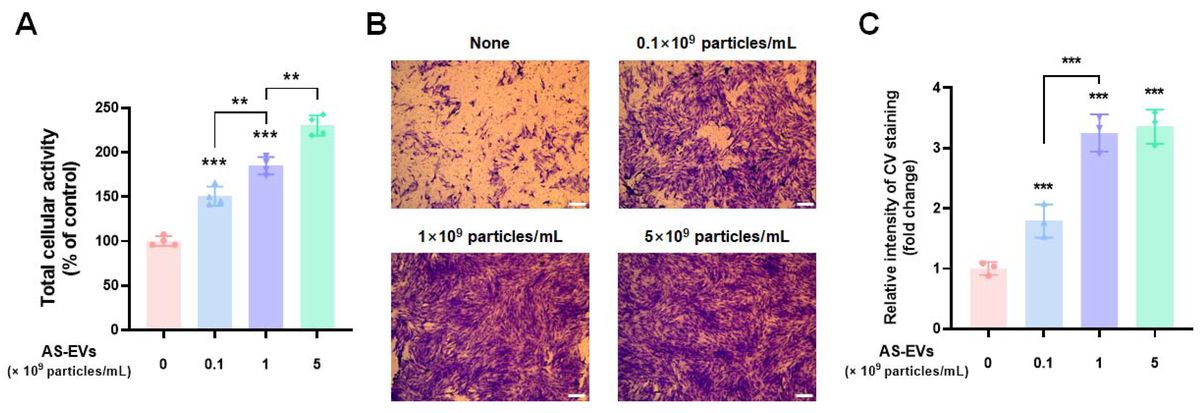 Figure 1. AS-EVs Promote Proliferation and Migration of Human Dermal Fibroblasts (HDFs). (A) WST-8 assay evaluating the viability of HDFs after 48 h incubation with AS-EVs in serum-free DMEM/F12. (B) Transwell migration assay showing enhanced migration of HDFs following 24 h AS-EVs treatment. Cells on the bottom side of the membrane were stained with crystal violet (CV) and fixed with 4% paraformaldehyde. Scale bar: 200 μm. (C) Quantification of migrated cells by measuring CV absorbance at 560 nm.
Figure 1. AS-EVs Promote Proliferation and Migration of Human Dermal Fibroblasts (HDFs). (A) WST-8 assay evaluating the viability of HDFs after 48 h incubation with AS-EVs in serum-free DMEM/F12. (B) Transwell migration assay showing enhanced migration of HDFs following 24 h AS-EVs treatment. Cells on the bottom side of the membrane were stained with crystal violet (CV) and fixed with 4% paraformaldehyde. Scale bar: 200 μm. (C) Quantification of migrated cells by measuring CV absorbance at 560 nm.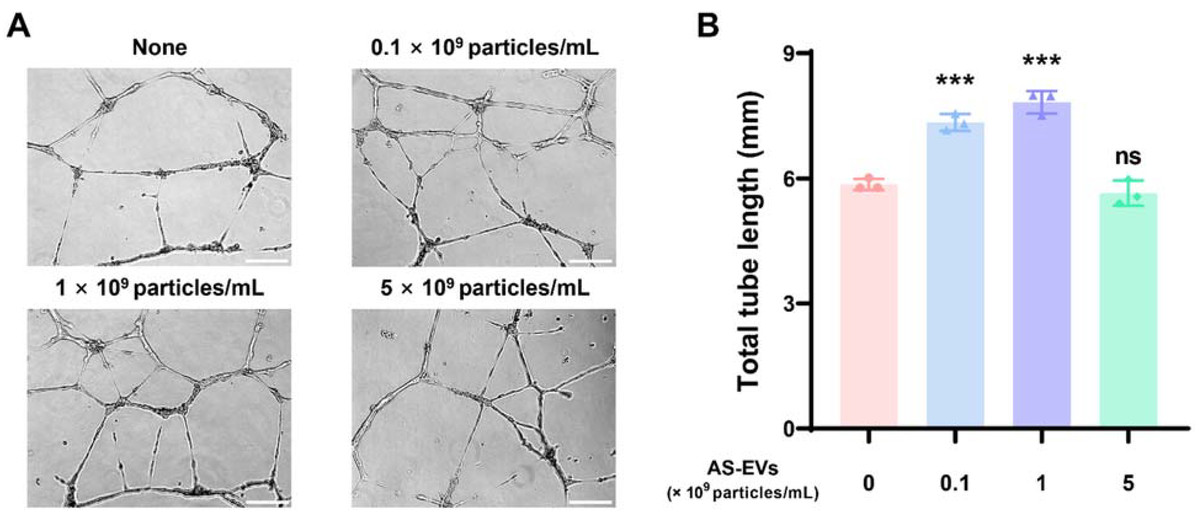 Figure 2. AS-EVs Enhance Capillary-Like Tube Formation in Human Umbilical Vein Endothelial Cells (HUVECs). (A) Representative images of capillary-like structures formed by HUVECs after 16 h of AS-EVs treatment on Matrigel in EGM-2 medium. Scale bar: 200 μm. (B) Quantification of total tube length using ImageJ.
Figure 2. AS-EVs Enhance Capillary-Like Tube Formation in Human Umbilical Vein Endothelial Cells (HUVECs). (A) Representative images of capillary-like structures formed by HUVECs after 16 h of AS-EVs treatment on Matrigel in EGM-2 medium. Scale bar: 200 μm. (B) Quantification of total tube length using ImageJ.